Nursing Activities Report: Respiratory, Cardiology, and Stroke Care
VerifiedAdded on 2023/01/03
|16
|3812
|58
Report
AI Summary
This report presents an analysis of various nursing activities undertaken, focusing on respiratory, cardiology, and stroke care. The activities include online tutorials and case studies from different providers, such as NPS Medicine Wise Learning and The Heart Foundation. The report details the types of activities, dates completed, time taken, and reflections on learning needs, learned information, and application to practice. Specific topics covered include inhaled medicines management, asthma inhaler techniques, asthma control in children, heart health, and stroke modules. Each activity is thoroughly examined, providing insights into the management of different health conditions and the application of evidence-based practices in nursing care. References for each activity are also provided.
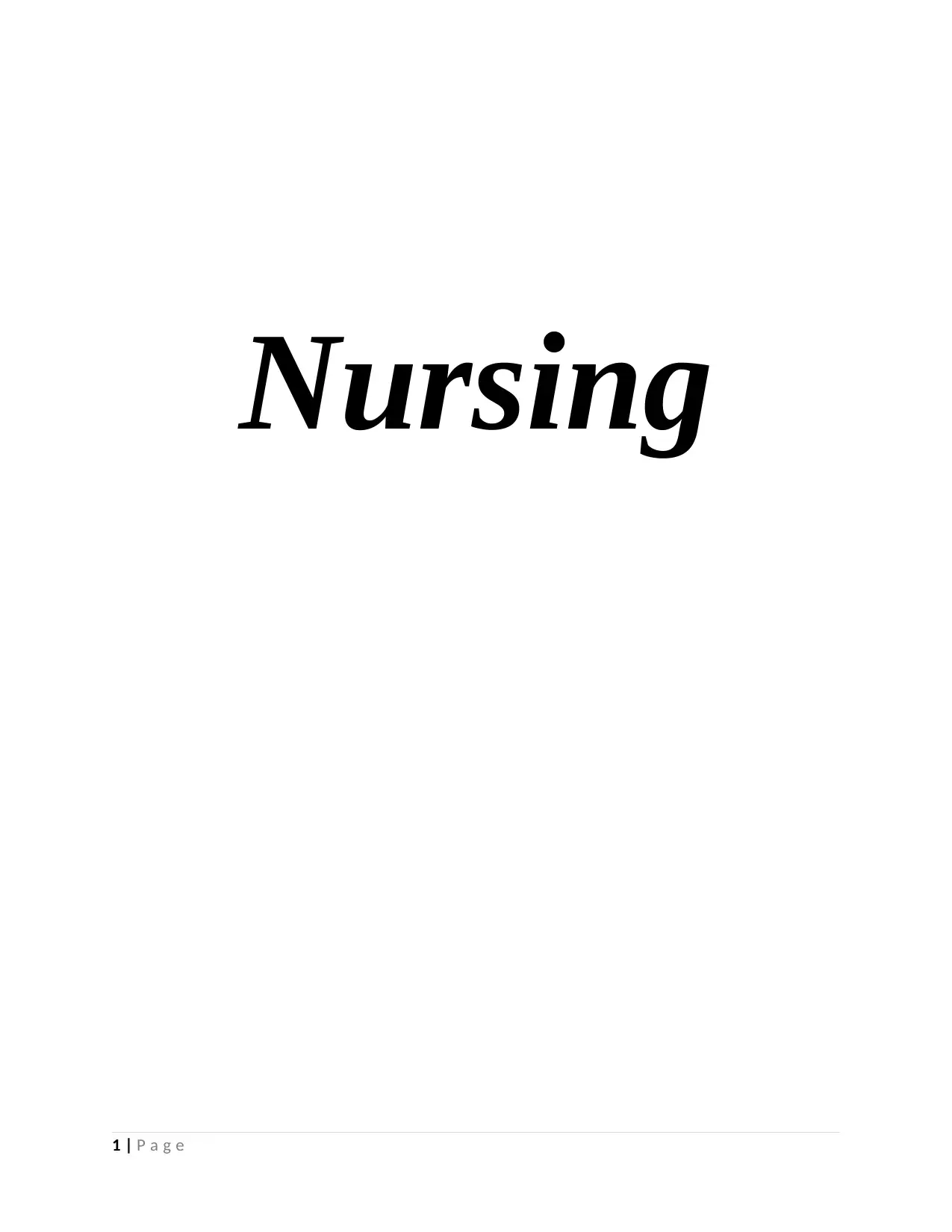
Nursing
1 | P a g e
1 | P a g e
Paraphrase This Document
Need a fresh take? Get an instant paraphrase of this document with our AI Paraphraser

Introduction
The assignment has been covered into 8 title of activity table. In two tables; time taken extend upto 2
hours. Three respiratory, cardiology and stroke activities have been discussed; additional to this one
activity has been taken from respiratory itself.
2 | P a g e
The assignment has been covered into 8 title of activity table. In two tables; time taken extend upto 2
hours. Three respiratory, cardiology and stroke activities have been discussed; additional to this one
activity has been taken from respiratory itself.
2 | P a g e
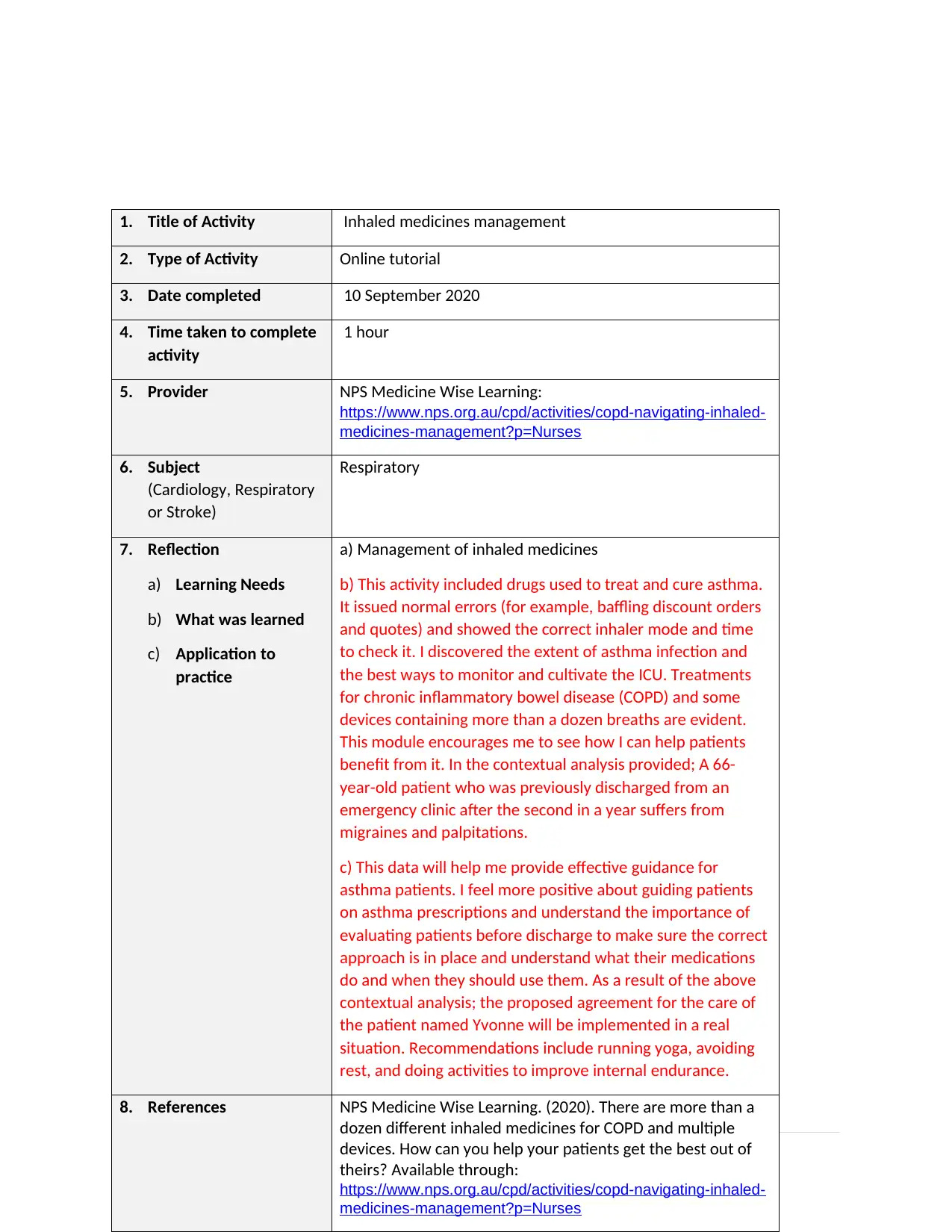
3 | P a g e
1. Title of Activity Inhaled medicines management
2. Type of Activity Online tutorial
3. Date completed 10 September 2020
4. Time taken to complete
activity
1 hour
5. Provider NPS Medicine Wise Learning:
https://www.nps.org.au/cpd/activities/copd-navigating-inhaled-
medicines-management?p=Nurses
6. Subject
(Cardiology, Respiratory
or Stroke)
Respiratory
7. Reflection
a) Learning Needs
b) What was learned
c) Application to
practice
a) Management of inhaled medicines
b) This activity included drugs used to treat and cure asthma.
It issued normal errors (for example, baffling discount orders
and quotes) and showed the correct inhaler mode and time
to check it. I discovered the extent of asthma infection and
the best ways to monitor and cultivate the ICU. Treatments
for chronic inflammatory bowel disease (COPD) and some
devices containing more than a dozen breaths are evident.
This module encourages me to see how I can help patients
benefit from it. In the contextual analysis provided; A 66-
year-old patient who was previously discharged from an
emergency clinic after the second in a year suffers from
migraines and palpitations.
c) This data will help me provide effective guidance for
asthma patients. I feel more positive about guiding patients
on asthma prescriptions and understand the importance of
evaluating patients before discharge to make sure the correct
approach is in place and understand what their medications
do and when they should use them. As a result of the above
contextual analysis; the proposed agreement for the care of
the patient named Yvonne will be implemented in a real
situation. Recommendations include running yoga, avoiding
rest, and doing activities to improve internal endurance.
8. References NPS Medicine Wise Learning. (2020). There are more than a
dozen different inhaled medicines for COPD and multiple
devices. How can you help your patients get the best out of
theirs? Available through:
https://www.nps.org.au/cpd/activities/copd-navigating-inhaled-
medicines-management?p=Nurses
1. Title of Activity Inhaled medicines management
2. Type of Activity Online tutorial
3. Date completed 10 September 2020
4. Time taken to complete
activity
1 hour
5. Provider NPS Medicine Wise Learning:
https://www.nps.org.au/cpd/activities/copd-navigating-inhaled-
medicines-management?p=Nurses
6. Subject
(Cardiology, Respiratory
or Stroke)
Respiratory
7. Reflection
a) Learning Needs
b) What was learned
c) Application to
practice
a) Management of inhaled medicines
b) This activity included drugs used to treat and cure asthma.
It issued normal errors (for example, baffling discount orders
and quotes) and showed the correct inhaler mode and time
to check it. I discovered the extent of asthma infection and
the best ways to monitor and cultivate the ICU. Treatments
for chronic inflammatory bowel disease (COPD) and some
devices containing more than a dozen breaths are evident.
This module encourages me to see how I can help patients
benefit from it. In the contextual analysis provided; A 66-
year-old patient who was previously discharged from an
emergency clinic after the second in a year suffers from
migraines and palpitations.
c) This data will help me provide effective guidance for
asthma patients. I feel more positive about guiding patients
on asthma prescriptions and understand the importance of
evaluating patients before discharge to make sure the correct
approach is in place and understand what their medications
do and when they should use them. As a result of the above
contextual analysis; the proposed agreement for the care of
the patient named Yvonne will be implemented in a real
situation. Recommendations include running yoga, avoiding
rest, and doing activities to improve internal endurance.
8. References NPS Medicine Wise Learning. (2020). There are more than a
dozen different inhaled medicines for COPD and multiple
devices. How can you help your patients get the best out of
theirs? Available through:
https://www.nps.org.au/cpd/activities/copd-navigating-inhaled-
medicines-management?p=Nurses
⊘ This is a preview!⊘
Do you want full access?
Subscribe today to unlock all pages.

Trusted by 1+ million students worldwide
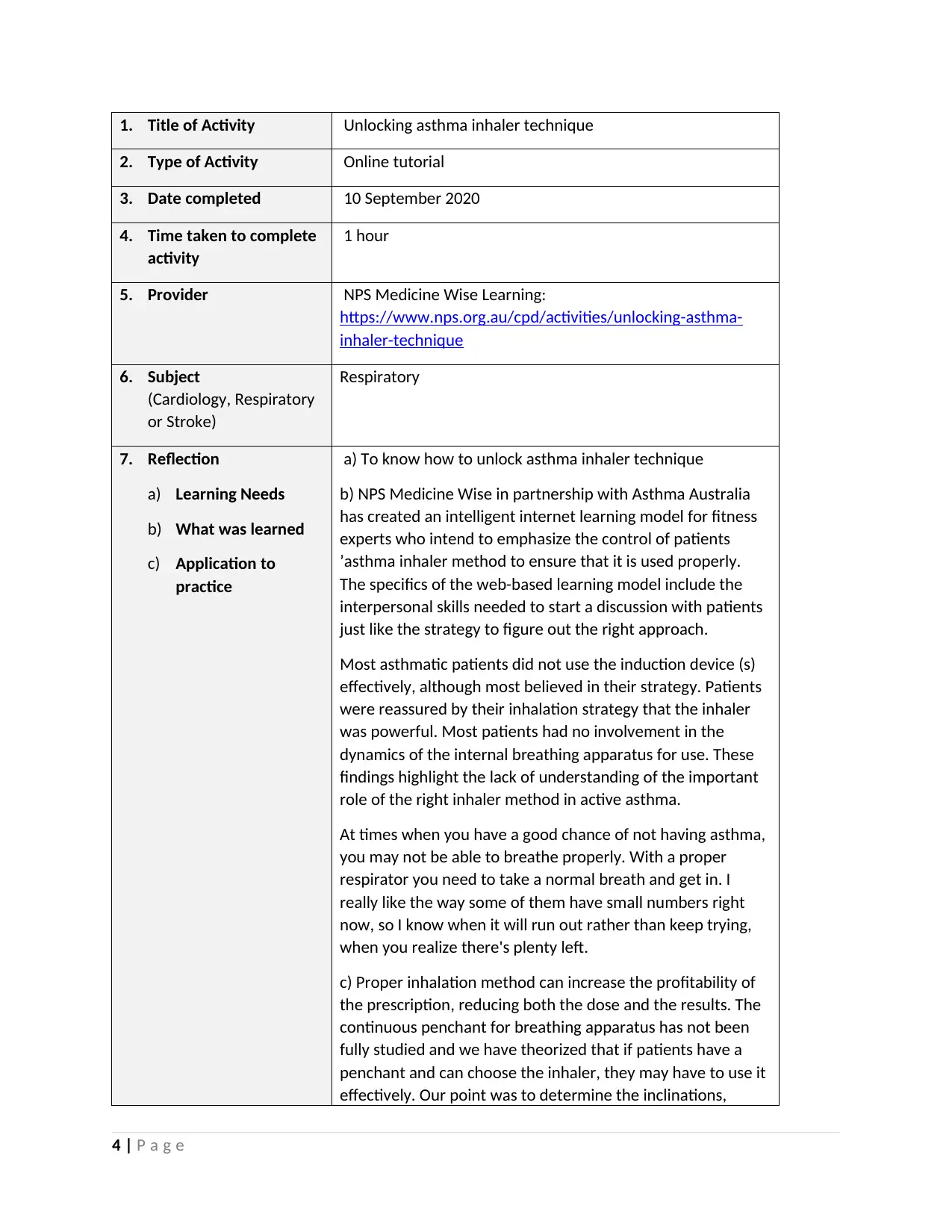
1. Title of Activity Unlocking asthma inhaler technique
2. Type of Activity Online tutorial
3. Date completed 10 September 2020
4. Time taken to complete
activity
1 hour
5. Provider NPS Medicine Wise Learning:
https://www.nps.org.au/cpd/activities/unlocking-asthma-
inhaler-technique
6. Subject
(Cardiology, Respiratory
or Stroke)
Respiratory
7. Reflection
a) Learning Needs
b) What was learned
c) Application to
practice
a) To know how to unlock asthma inhaler technique
b) NPS Medicine Wise in partnership with Asthma Australia
has created an intelligent internet learning model for fitness
experts who intend to emphasize the control of patients
’asthma inhaler method to ensure that it is used properly.
The specifics of the web-based learning model include the
interpersonal skills needed to start a discussion with patients
just like the strategy to figure out the right approach.
Most asthmatic patients did not use the induction device (s)
effectively, although most believed in their strategy. Patients
were reassured by their inhalation strategy that the inhaler
was powerful. Most patients had no involvement in the
dynamics of the internal breathing apparatus for use. These
findings highlight the lack of understanding of the important
role of the right inhaler method in active asthma.
At times when you have a good chance of not having asthma,
you may not be able to breathe properly. With a proper
respirator you need to take a normal breath and get in. I
really like the way some of them have small numbers right
now, so I know when it will run out rather than keep trying,
when you realize there's plenty left.
c) Proper inhalation method can increase the profitability of
the prescription, reducing both the dose and the results. The
continuous penchant for breathing apparatus has not been
fully studied and we have theorized that if patients have a
penchant and can choose the inhaler, they may have to use it
effectively. Our point was to determine the inclinations,
4 | P a g e
2. Type of Activity Online tutorial
3. Date completed 10 September 2020
4. Time taken to complete
activity
1 hour
5. Provider NPS Medicine Wise Learning:
https://www.nps.org.au/cpd/activities/unlocking-asthma-
inhaler-technique
6. Subject
(Cardiology, Respiratory
or Stroke)
Respiratory
7. Reflection
a) Learning Needs
b) What was learned
c) Application to
practice
a) To know how to unlock asthma inhaler technique
b) NPS Medicine Wise in partnership with Asthma Australia
has created an intelligent internet learning model for fitness
experts who intend to emphasize the control of patients
’asthma inhaler method to ensure that it is used properly.
The specifics of the web-based learning model include the
interpersonal skills needed to start a discussion with patients
just like the strategy to figure out the right approach.
Most asthmatic patients did not use the induction device (s)
effectively, although most believed in their strategy. Patients
were reassured by their inhalation strategy that the inhaler
was powerful. Most patients had no involvement in the
dynamics of the internal breathing apparatus for use. These
findings highlight the lack of understanding of the important
role of the right inhaler method in active asthma.
At times when you have a good chance of not having asthma,
you may not be able to breathe properly. With a proper
respirator you need to take a normal breath and get in. I
really like the way some of them have small numbers right
now, so I know when it will run out rather than keep trying,
when you realize there's plenty left.
c) Proper inhalation method can increase the profitability of
the prescription, reducing both the dose and the results. The
continuous penchant for breathing apparatus has not been
fully studied and we have theorized that if patients have a
penchant and can choose the inhaler, they may have to use it
effectively. Our point was to determine the inclinations,
4 | P a g e
Paraphrase This Document
Need a fresh take? Get an instant paraphrase of this document with our AI Paraphraser
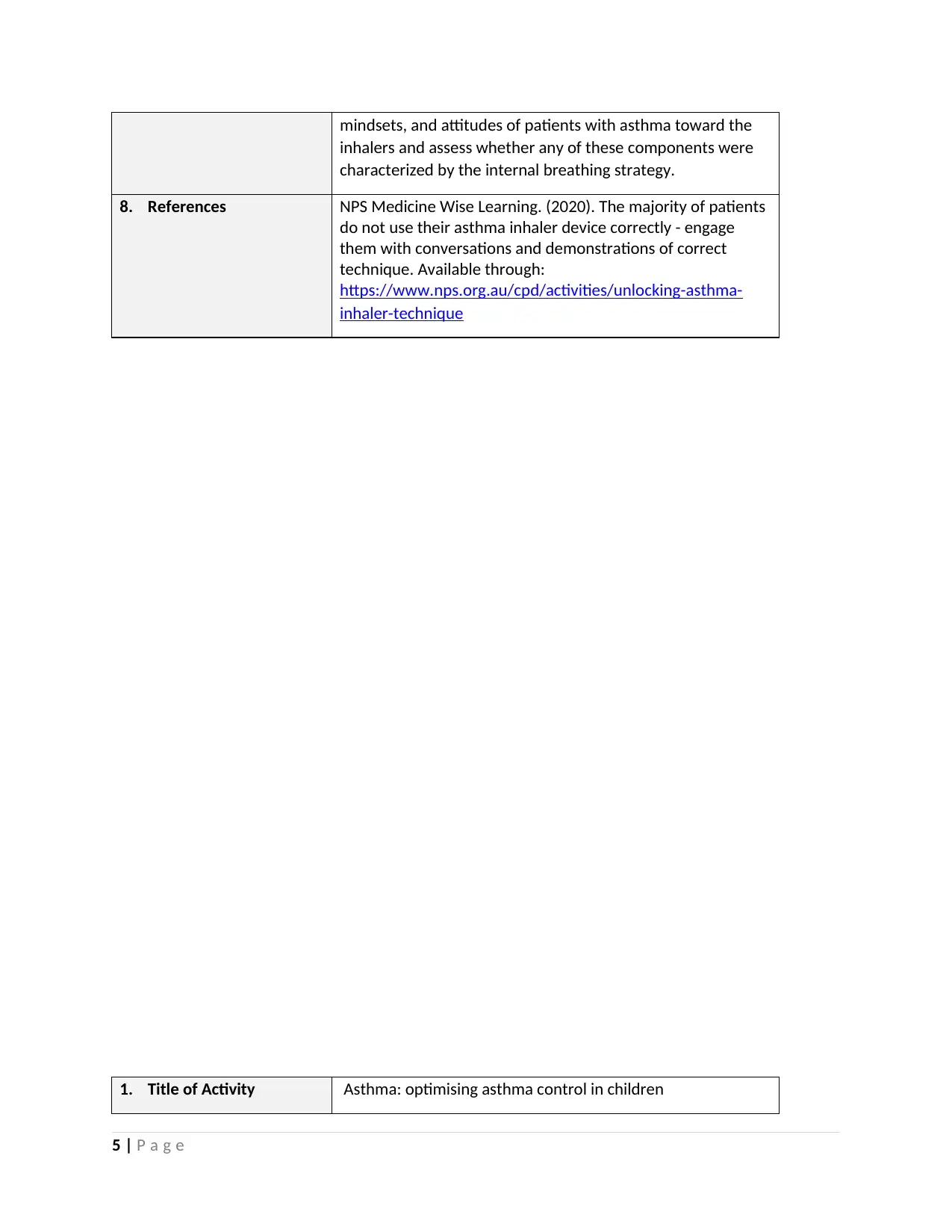
mindsets, and attitudes of patients with asthma toward the
inhalers and assess whether any of these components were
characterized by the internal breathing strategy.
8. References NPS Medicine Wise Learning. (2020). The majority of patients
do not use their asthma inhaler device correctly - engage
them with conversations and demonstrations of correct
technique. Available through:
https://www.nps.org.au/cpd/activities/unlocking-asthma-
inhaler-technique
1. Title of Activity Asthma: optimising asthma control in children
5 | P a g e
inhalers and assess whether any of these components were
characterized by the internal breathing strategy.
8. References NPS Medicine Wise Learning. (2020). The majority of patients
do not use their asthma inhaler device correctly - engage
them with conversations and demonstrations of correct
technique. Available through:
https://www.nps.org.au/cpd/activities/unlocking-asthma-
inhaler-technique
1. Title of Activity Asthma: optimising asthma control in children
5 | P a g e
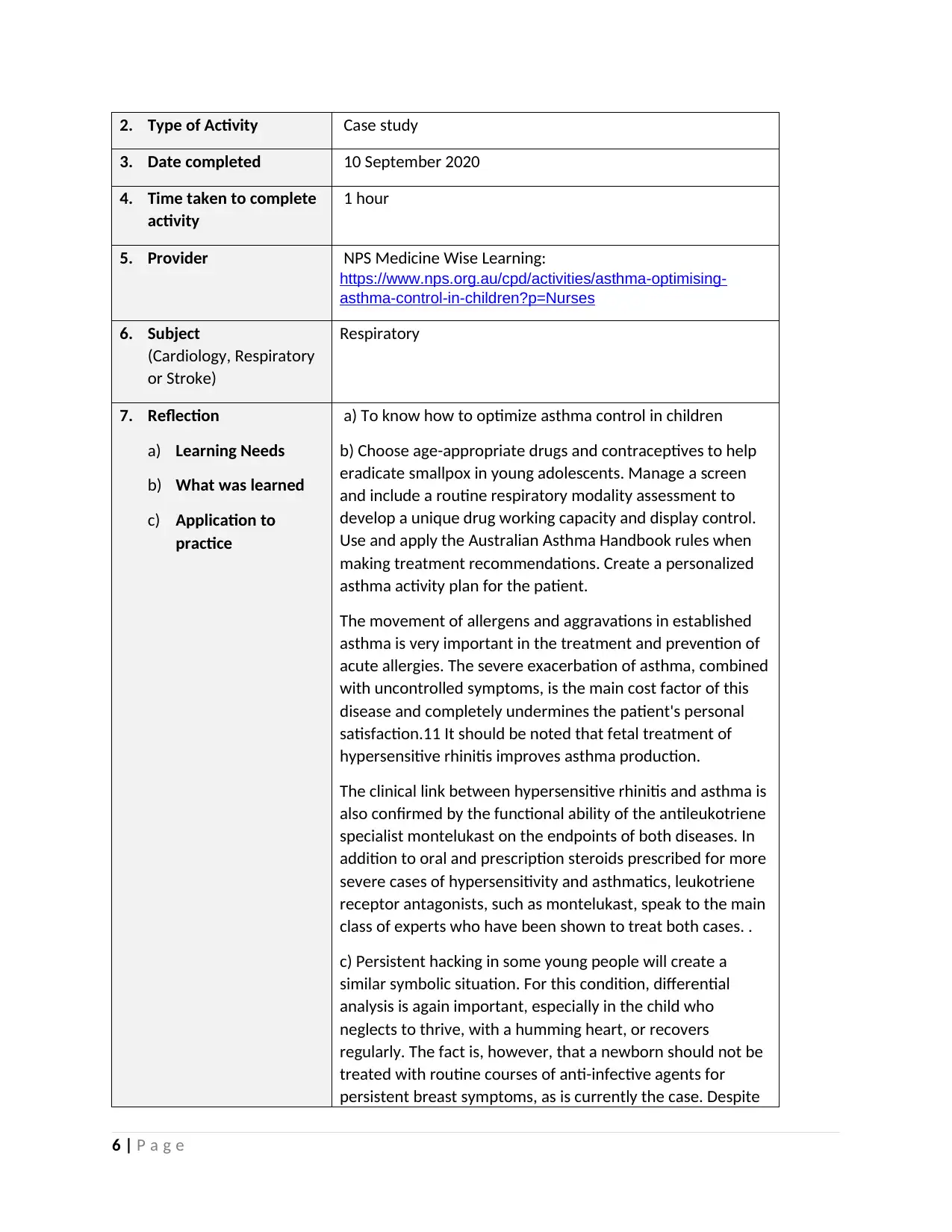
2. Type of Activity Case study
3. Date completed 10 September 2020
4. Time taken to complete
activity
1 hour
5. Provider NPS Medicine Wise Learning:
https://www.nps.org.au/cpd/activities/asthma-optimising-
asthma-control-in-children?p=Nurses
6. Subject
(Cardiology, Respiratory
or Stroke)
Respiratory
7. Reflection
a) Learning Needs
b) What was learned
c) Application to
practice
a) To know how to optimize asthma control in children
b) Choose age-appropriate drugs and contraceptives to help
eradicate smallpox in young adolescents. Manage a screen
and include a routine respiratory modality assessment to
develop a unique drug working capacity and display control.
Use and apply the Australian Asthma Handbook rules when
making treatment recommendations. Create a personalized
asthma activity plan for the patient.
The movement of allergens and aggravations in established
asthma is very important in the treatment and prevention of
acute allergies. The severe exacerbation of asthma, combined
with uncontrolled symptoms, is the main cost factor of this
disease and completely undermines the patient's personal
satisfaction.11 It should be noted that fetal treatment of
hypersensitive rhinitis improves asthma production.
The clinical link between hypersensitive rhinitis and asthma is
also confirmed by the functional ability of the antileukotriene
specialist montelukast on the endpoints of both diseases. In
addition to oral and prescription steroids prescribed for more
severe cases of hypersensitivity and asthmatics, leukotriene
receptor antagonists, such as montelukast, speak to the main
class of experts who have been shown to treat both cases. .
c) Persistent hacking in some young people will create a
similar symbolic situation. For this condition, differential
analysis is again important, especially in the child who
neglects to thrive, with a humming heart, or recovers
regularly. The fact is, however, that a newborn should not be
treated with routine courses of anti-infective agents for
persistent breast symptoms, as is currently the case. Despite
6 | P a g e
3. Date completed 10 September 2020
4. Time taken to complete
activity
1 hour
5. Provider NPS Medicine Wise Learning:
https://www.nps.org.au/cpd/activities/asthma-optimising-
asthma-control-in-children?p=Nurses
6. Subject
(Cardiology, Respiratory
or Stroke)
Respiratory
7. Reflection
a) Learning Needs
b) What was learned
c) Application to
practice
a) To know how to optimize asthma control in children
b) Choose age-appropriate drugs and contraceptives to help
eradicate smallpox in young adolescents. Manage a screen
and include a routine respiratory modality assessment to
develop a unique drug working capacity and display control.
Use and apply the Australian Asthma Handbook rules when
making treatment recommendations. Create a personalized
asthma activity plan for the patient.
The movement of allergens and aggravations in established
asthma is very important in the treatment and prevention of
acute allergies. The severe exacerbation of asthma, combined
with uncontrolled symptoms, is the main cost factor of this
disease and completely undermines the patient's personal
satisfaction.11 It should be noted that fetal treatment of
hypersensitive rhinitis improves asthma production.
The clinical link between hypersensitive rhinitis and asthma is
also confirmed by the functional ability of the antileukotriene
specialist montelukast on the endpoints of both diseases. In
addition to oral and prescription steroids prescribed for more
severe cases of hypersensitivity and asthmatics, leukotriene
receptor antagonists, such as montelukast, speak to the main
class of experts who have been shown to treat both cases. .
c) Persistent hacking in some young people will create a
similar symbolic situation. For this condition, differential
analysis is again important, especially in the child who
neglects to thrive, with a humming heart, or recovers
regularly. The fact is, however, that a newborn should not be
treated with routine courses of anti-infective agents for
persistent breast symptoms, as is currently the case. Despite
6 | P a g e
⊘ This is a preview!⊘
Do you want full access?
Subscribe today to unlock all pages.

Trusted by 1+ million students worldwide
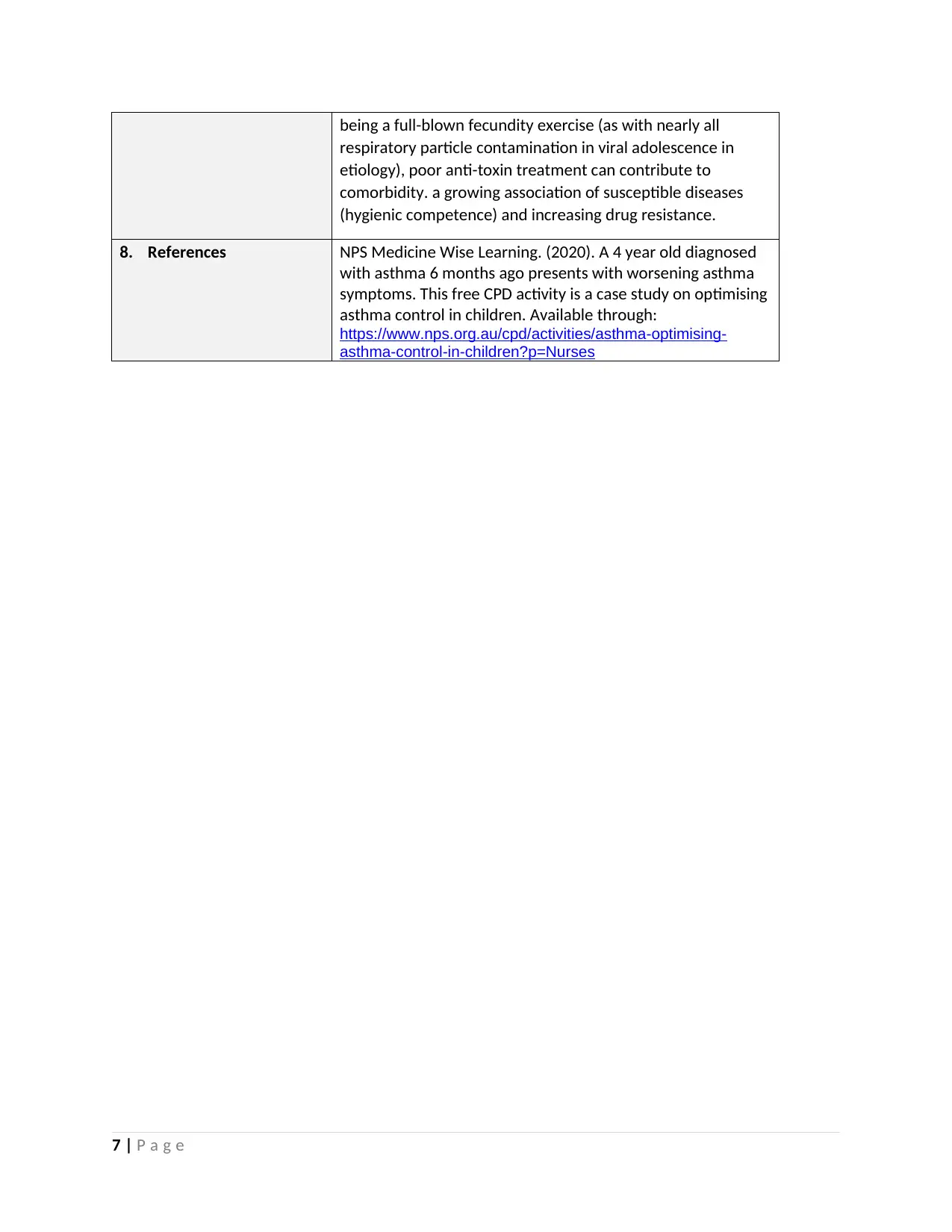
being a full-blown fecundity exercise (as with nearly all
respiratory particle contamination in viral adolescence in
etiology), poor anti-toxin treatment can contribute to
comorbidity. a growing association of susceptible diseases
(hygienic competence) and increasing drug resistance.
8. References NPS Medicine Wise Learning. (2020). A 4 year old diagnosed
with asthma 6 months ago presents with worsening asthma
symptoms. This free CPD activity is a case study on optimising
asthma control in children. Available through:
https://www.nps.org.au/cpd/activities/asthma-optimising-
asthma-control-in-children?p=Nurses
7 | P a g e
respiratory particle contamination in viral adolescence in
etiology), poor anti-toxin treatment can contribute to
comorbidity. a growing association of susceptible diseases
(hygienic competence) and increasing drug resistance.
8. References NPS Medicine Wise Learning. (2020). A 4 year old diagnosed
with asthma 6 months ago presents with worsening asthma
symptoms. This free CPD activity is a case study on optimising
asthma control in children. Available through:
https://www.nps.org.au/cpd/activities/asthma-optimising-
asthma-control-in-children?p=Nurses
7 | P a g e
Paraphrase This Document
Need a fresh take? Get an instant paraphrase of this document with our AI Paraphraser
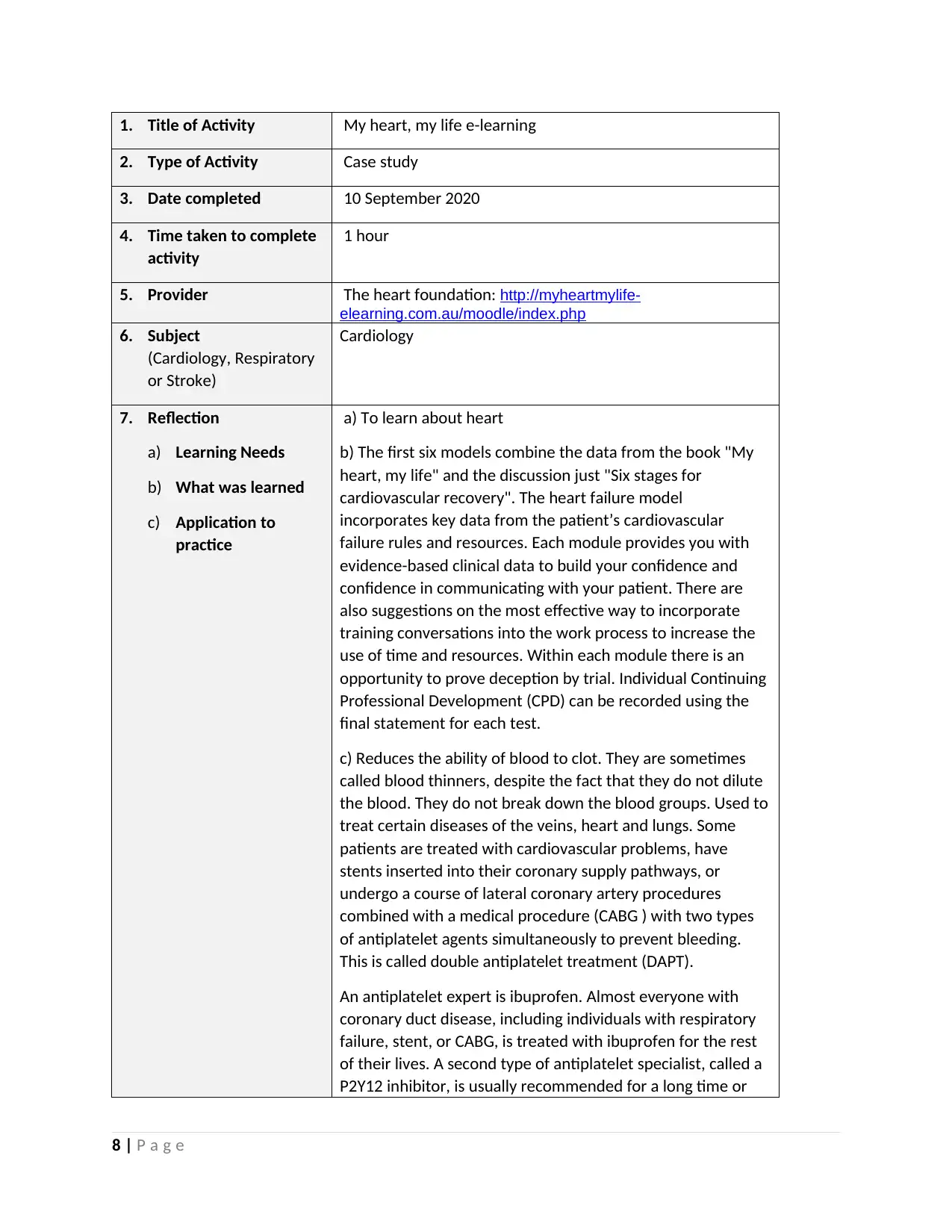
1. Title of Activity My heart, my life e-learning
2. Type of Activity Case study
3. Date completed 10 September 2020
4. Time taken to complete
activity
1 hour
5. Provider The heart foundation: http://myheartmylife-
elearning.com.au/moodle/index.php
6. Subject
(Cardiology, Respiratory
or Stroke)
Cardiology
7. Reflection
a) Learning Needs
b) What was learned
c) Application to
practice
a) To learn about heart
b) The first six models combine the data from the book "My
heart, my life" and the discussion just "Six stages for
cardiovascular recovery". The heart failure model
incorporates key data from the patient’s cardiovascular
failure rules and resources. Each module provides you with
evidence-based clinical data to build your confidence and
confidence in communicating with your patient. There are
also suggestions on the most effective way to incorporate
training conversations into the work process to increase the
use of time and resources. Within each module there is an
opportunity to prove deception by trial. Individual Continuing
Professional Development (CPD) can be recorded using the
final statement for each test.
c) Reduces the ability of blood to clot. They are sometimes
called blood thinners, despite the fact that they do not dilute
the blood. They do not break down the blood groups. Used to
treat certain diseases of the veins, heart and lungs. Some
patients are treated with cardiovascular problems, have
stents inserted into their coronary supply pathways, or
undergo a course of lateral coronary artery procedures
combined with a medical procedure (CABG ) with two types
of antiplatelet agents simultaneously to prevent bleeding.
This is called double antiplatelet treatment (DAPT).
An antiplatelet expert is ibuprofen. Almost everyone with
coronary duct disease, including individuals with respiratory
failure, stent, or CABG, is treated with ibuprofen for the rest
of their lives. A second type of antiplatelet specialist, called a
P2Y12 inhibitor, is usually recommended for a long time or
8 | P a g e
2. Type of Activity Case study
3. Date completed 10 September 2020
4. Time taken to complete
activity
1 hour
5. Provider The heart foundation: http://myheartmylife-
elearning.com.au/moodle/index.php
6. Subject
(Cardiology, Respiratory
or Stroke)
Cardiology
7. Reflection
a) Learning Needs
b) What was learned
c) Application to
practice
a) To learn about heart
b) The first six models combine the data from the book "My
heart, my life" and the discussion just "Six stages for
cardiovascular recovery". The heart failure model
incorporates key data from the patient’s cardiovascular
failure rules and resources. Each module provides you with
evidence-based clinical data to build your confidence and
confidence in communicating with your patient. There are
also suggestions on the most effective way to incorporate
training conversations into the work process to increase the
use of time and resources. Within each module there is an
opportunity to prove deception by trial. Individual Continuing
Professional Development (CPD) can be recorded using the
final statement for each test.
c) Reduces the ability of blood to clot. They are sometimes
called blood thinners, despite the fact that they do not dilute
the blood. They do not break down the blood groups. Used to
treat certain diseases of the veins, heart and lungs. Some
patients are treated with cardiovascular problems, have
stents inserted into their coronary supply pathways, or
undergo a course of lateral coronary artery procedures
combined with a medical procedure (CABG ) with two types
of antiplatelet agents simultaneously to prevent bleeding.
This is called double antiplatelet treatment (DAPT).
An antiplatelet expert is ibuprofen. Almost everyone with
coronary duct disease, including individuals with respiratory
failure, stent, or CABG, is treated with ibuprofen for the rest
of their lives. A second type of antiplatelet specialist, called a
P2Y12 inhibitor, is usually recommended for a long time or
8 | P a g e
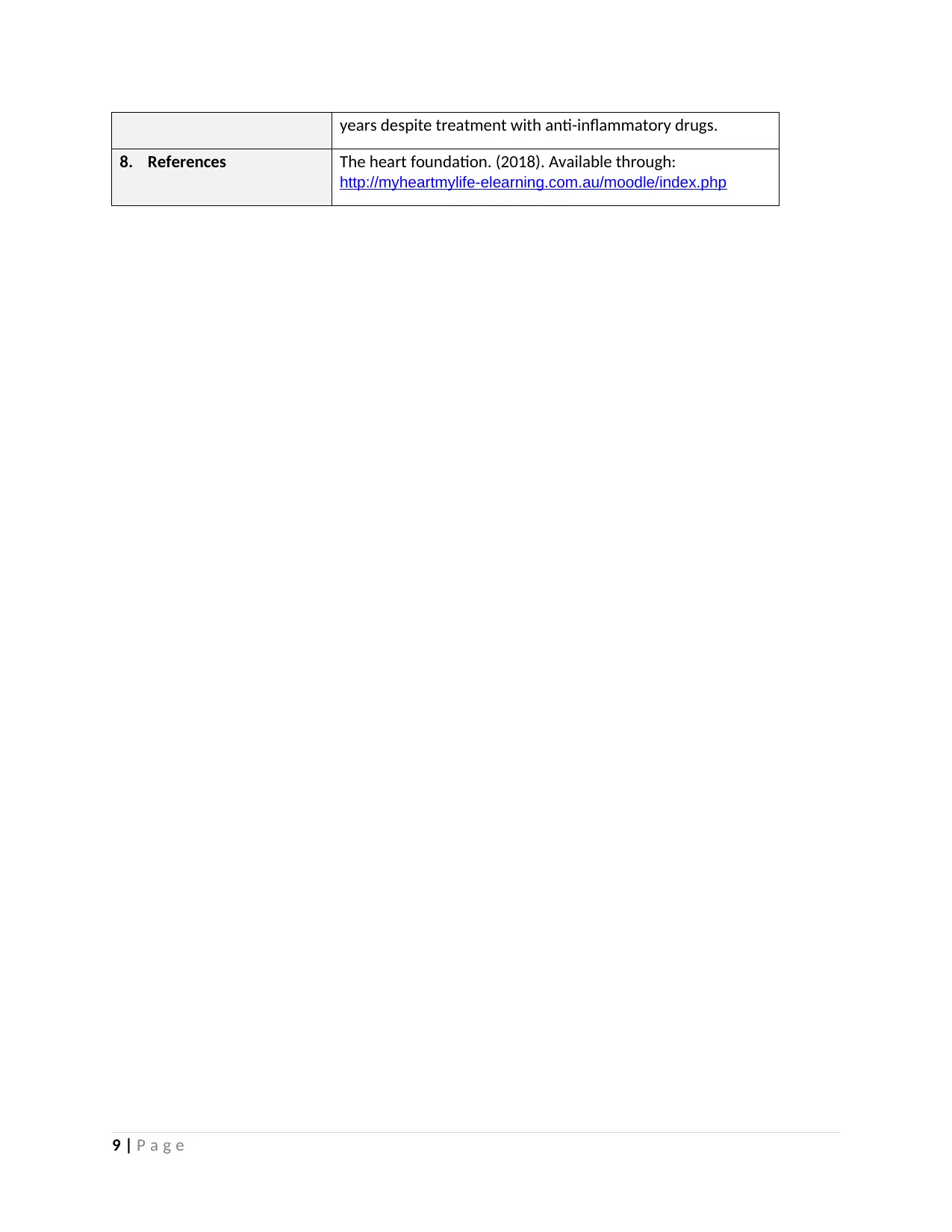
years despite treatment with anti-inflammatory drugs.
8. References The heart foundation. (2018). Available through:
http://myheartmylife-elearning.com.au/moodle/index.php
9 | P a g e
8. References The heart foundation. (2018). Available through:
http://myheartmylife-elearning.com.au/moodle/index.php
9 | P a g e
⊘ This is a preview!⊘
Do you want full access?
Subscribe today to unlock all pages.

Trusted by 1+ million students worldwide
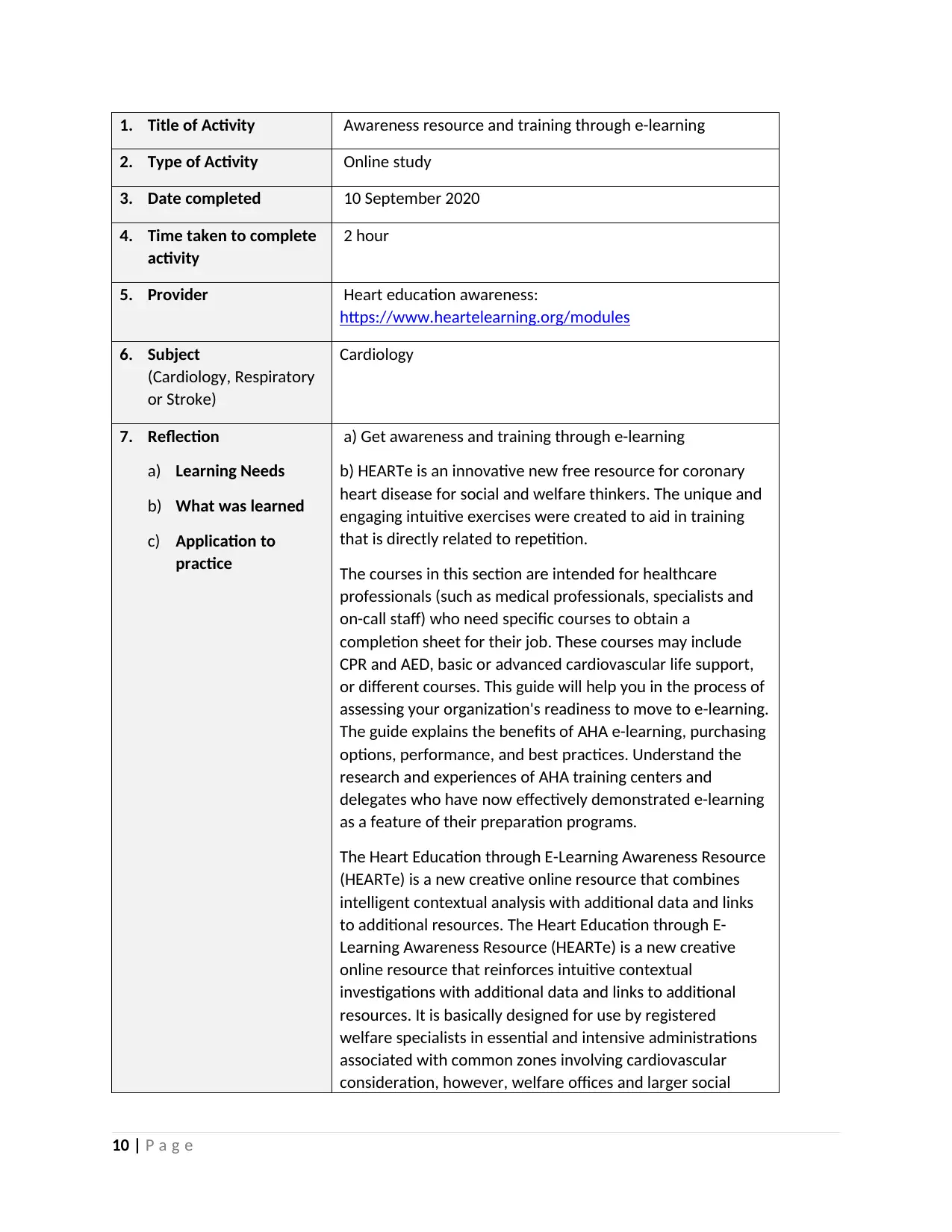
1. Title of Activity Awareness resource and training through e-learning
2. Type of Activity Online study
3. Date completed 10 September 2020
4. Time taken to complete
activity
2 hour
5. Provider Heart education awareness:
https://www.heartelearning.org/modules
6. Subject
(Cardiology, Respiratory
or Stroke)
Cardiology
7. Reflection
a) Learning Needs
b) What was learned
c) Application to
practice
a) Get awareness and training through e-learning
b) HEARTe is an innovative new free resource for coronary
heart disease for social and welfare thinkers. The unique and
engaging intuitive exercises were created to aid in training
that is directly related to repetition.
The courses in this section are intended for healthcare
professionals (such as medical professionals, specialists and
on-call staff) who need specific courses to obtain a
completion sheet for their job. These courses may include
CPR and AED, basic or advanced cardiovascular life support,
or different courses. This guide will help you in the process of
assessing your organization's readiness to move to e-learning.
The guide explains the benefits of AHA e-learning, purchasing
options, performance, and best practices. Understand the
research and experiences of AHA training centers and
delegates who have now effectively demonstrated e-learning
as a feature of their preparation programs.
The Heart Education through E-Learning Awareness Resource
(HEARTe) is a new creative online resource that combines
intelligent contextual analysis with additional data and links
to additional resources. The Heart Education through E-
Learning Awareness Resource (HEARTe) is a new creative
online resource that reinforces intuitive contextual
investigations with additional data and links to additional
resources. It is basically designed for use by registered
welfare specialists in essential and intensive administrations
associated with common zones involving cardiovascular
consideration, however, welfare offices and larger social
10 | P a g e
2. Type of Activity Online study
3. Date completed 10 September 2020
4. Time taken to complete
activity
2 hour
5. Provider Heart education awareness:
https://www.heartelearning.org/modules
6. Subject
(Cardiology, Respiratory
or Stroke)
Cardiology
7. Reflection
a) Learning Needs
b) What was learned
c) Application to
practice
a) Get awareness and training through e-learning
b) HEARTe is an innovative new free resource for coronary
heart disease for social and welfare thinkers. The unique and
engaging intuitive exercises were created to aid in training
that is directly related to repetition.
The courses in this section are intended for healthcare
professionals (such as medical professionals, specialists and
on-call staff) who need specific courses to obtain a
completion sheet for their job. These courses may include
CPR and AED, basic or advanced cardiovascular life support,
or different courses. This guide will help you in the process of
assessing your organization's readiness to move to e-learning.
The guide explains the benefits of AHA e-learning, purchasing
options, performance, and best practices. Understand the
research and experiences of AHA training centers and
delegates who have now effectively demonstrated e-learning
as a feature of their preparation programs.
The Heart Education through E-Learning Awareness Resource
(HEARTe) is a new creative online resource that combines
intelligent contextual analysis with additional data and links
to additional resources. The Heart Education through E-
Learning Awareness Resource (HEARTe) is a new creative
online resource that reinforces intuitive contextual
investigations with additional data and links to additional
resources. It is basically designed for use by registered
welfare specialists in essential and intensive administrations
associated with common zones involving cardiovascular
consideration, however, welfare offices and larger social
10 | P a g e
Paraphrase This Document
Need a fresh take? Get an instant paraphrase of this document with our AI Paraphraser
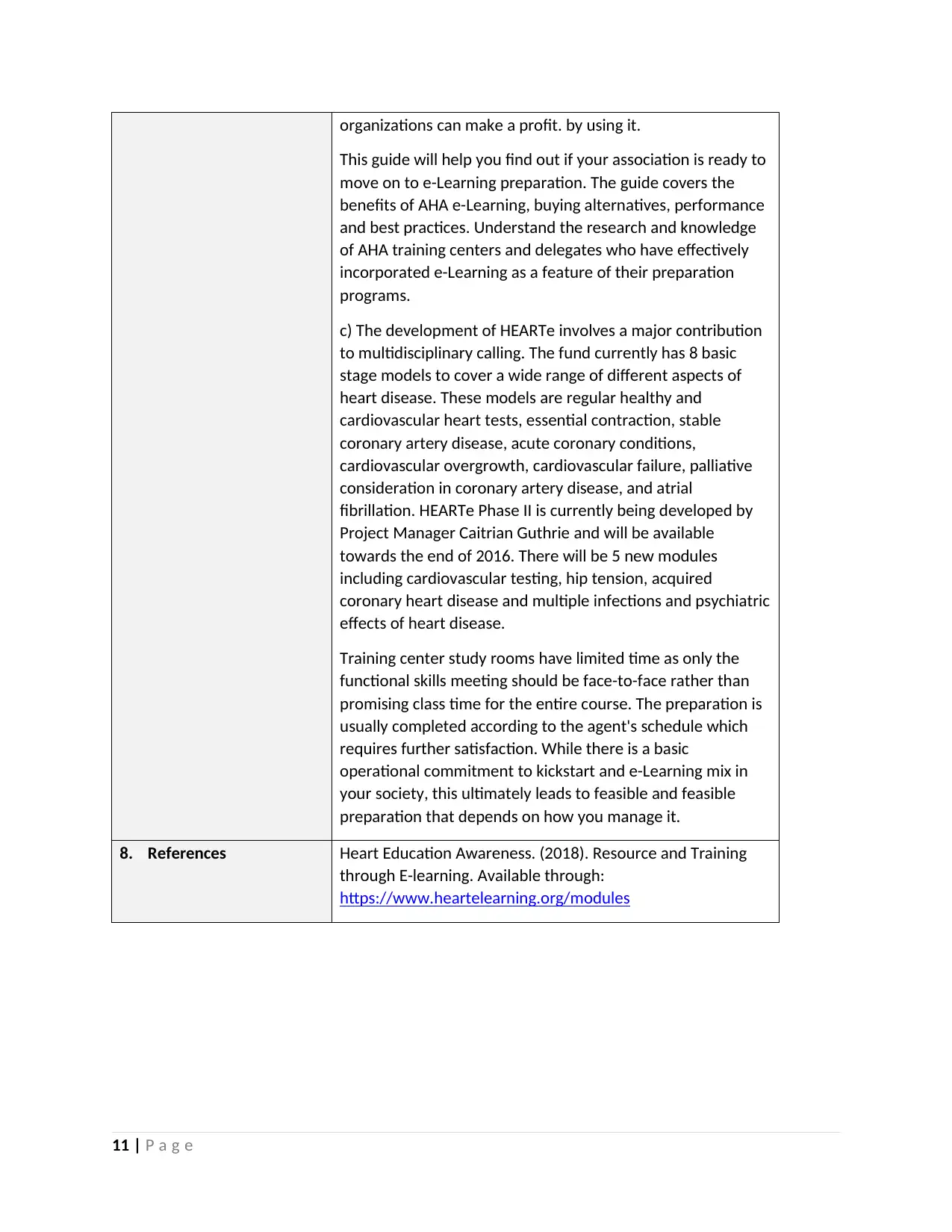
organizations can make a profit. by using it.
This guide will help you find out if your association is ready to
move on to e-Learning preparation. The guide covers the
benefits of AHA e-Learning, buying alternatives, performance
and best practices. Understand the research and knowledge
of AHA training centers and delegates who have effectively
incorporated e-Learning as a feature of their preparation
programs.
c) The development of HEARTe involves a major contribution
to multidisciplinary calling. The fund currently has 8 basic
stage models to cover a wide range of different aspects of
heart disease. These models are regular healthy and
cardiovascular heart tests, essential contraction, stable
coronary artery disease, acute coronary conditions,
cardiovascular overgrowth, cardiovascular failure, palliative
consideration in coronary artery disease, and atrial
fibrillation. HEARTe Phase II is currently being developed by
Project Manager Caitrian Guthrie and will be available
towards the end of 2016. There will be 5 new modules
including cardiovascular testing, hip tension, acquired
coronary heart disease and multiple infections and psychiatric
effects of heart disease.
Training center study rooms have limited time as only the
functional skills meeting should be face-to-face rather than
promising class time for the entire course. The preparation is
usually completed according to the agent's schedule which
requires further satisfaction. While there is a basic
operational commitment to kickstart and e-Learning mix in
your society, this ultimately leads to feasible and feasible
preparation that depends on how you manage it.
8. References Heart Education Awareness. (2018). Resource and Training
through E-learning. Available through:
https://www.heartelearning.org/modules
11 | P a g e
This guide will help you find out if your association is ready to
move on to e-Learning preparation. The guide covers the
benefits of AHA e-Learning, buying alternatives, performance
and best practices. Understand the research and knowledge
of AHA training centers and delegates who have effectively
incorporated e-Learning as a feature of their preparation
programs.
c) The development of HEARTe involves a major contribution
to multidisciplinary calling. The fund currently has 8 basic
stage models to cover a wide range of different aspects of
heart disease. These models are regular healthy and
cardiovascular heart tests, essential contraction, stable
coronary artery disease, acute coronary conditions,
cardiovascular overgrowth, cardiovascular failure, palliative
consideration in coronary artery disease, and atrial
fibrillation. HEARTe Phase II is currently being developed by
Project Manager Caitrian Guthrie and will be available
towards the end of 2016. There will be 5 new modules
including cardiovascular testing, hip tension, acquired
coronary heart disease and multiple infections and psychiatric
effects of heart disease.
Training center study rooms have limited time as only the
functional skills meeting should be face-to-face rather than
promising class time for the entire course. The preparation is
usually completed according to the agent's schedule which
requires further satisfaction. While there is a basic
operational commitment to kickstart and e-Learning mix in
your society, this ultimately leads to feasible and feasible
preparation that depends on how you manage it.
8. References Heart Education Awareness. (2018). Resource and Training
through E-learning. Available through:
https://www.heartelearning.org/modules
11 | P a g e
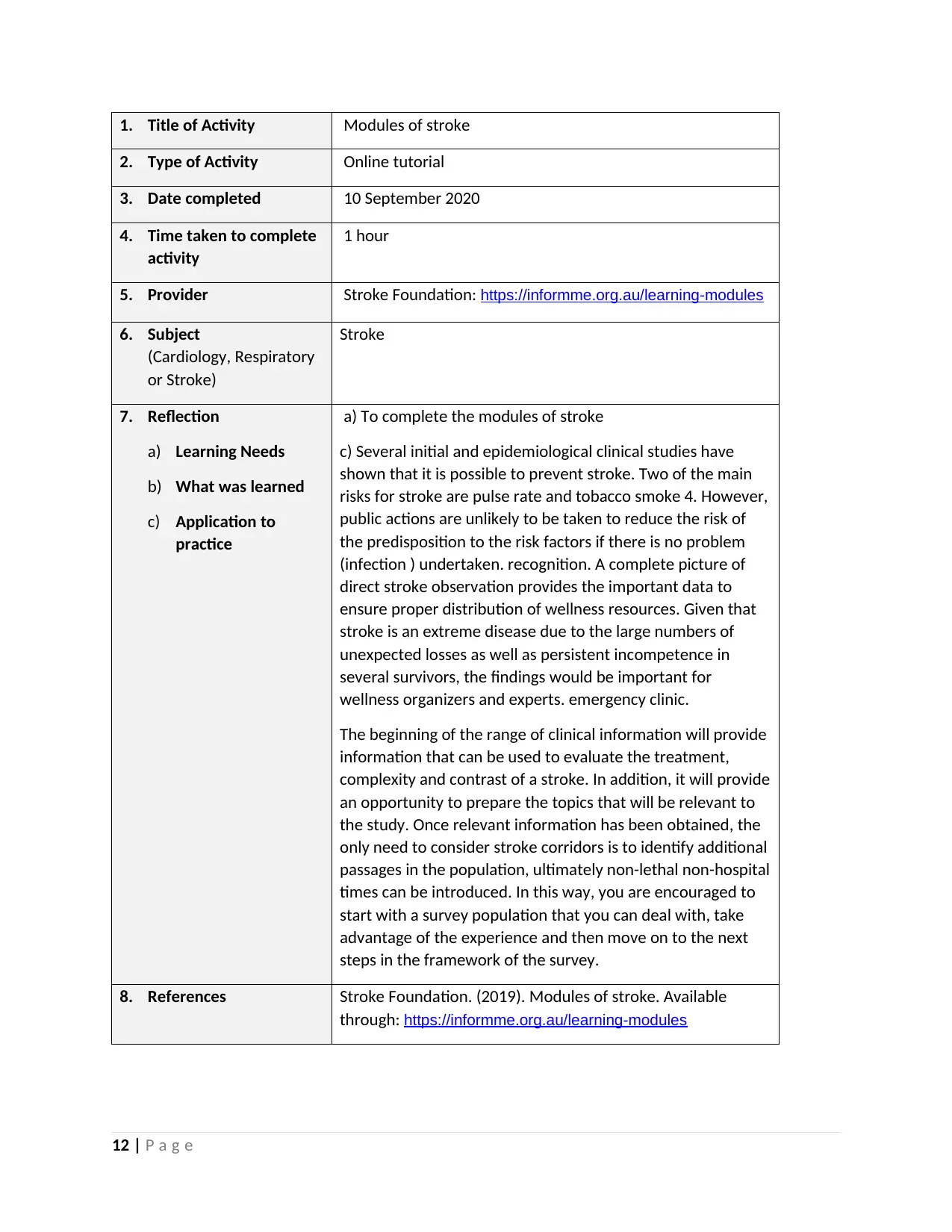
1. Title of Activity Modules of stroke
2. Type of Activity Online tutorial
3. Date completed 10 September 2020
4. Time taken to complete
activity
1 hour
5. Provider Stroke Foundation: https://informme.org.au/learning-modules
6. Subject
(Cardiology, Respiratory
or Stroke)
Stroke
7. Reflection
a) Learning Needs
b) What was learned
c) Application to
practice
a) To complete the modules of stroke
c) Several initial and epidemiological clinical studies have
shown that it is possible to prevent stroke. Two of the main
risks for stroke are pulse rate and tobacco smoke 4. However,
public actions are unlikely to be taken to reduce the risk of
the predisposition to the risk factors if there is no problem
(infection ) undertaken. recognition. A complete picture of
direct stroke observation provides the important data to
ensure proper distribution of wellness resources. Given that
stroke is an extreme disease due to the large numbers of
unexpected losses as well as persistent incompetence in
several survivors, the findings would be important for
wellness organizers and experts. emergency clinic.
The beginning of the range of clinical information will provide
information that can be used to evaluate the treatment,
complexity and contrast of a stroke. In addition, it will provide
an opportunity to prepare the topics that will be relevant to
the study. Once relevant information has been obtained, the
only need to consider stroke corridors is to identify additional
passages in the population, ultimately non-lethal non-hospital
times can be introduced. In this way, you are encouraged to
start with a survey population that you can deal with, take
advantage of the experience and then move on to the next
steps in the framework of the survey.
8. References Stroke Foundation. (2019). Modules of stroke. Available
through: https://informme.org.au/learning-modules
12 | P a g e
2. Type of Activity Online tutorial
3. Date completed 10 September 2020
4. Time taken to complete
activity
1 hour
5. Provider Stroke Foundation: https://informme.org.au/learning-modules
6. Subject
(Cardiology, Respiratory
or Stroke)
Stroke
7. Reflection
a) Learning Needs
b) What was learned
c) Application to
practice
a) To complete the modules of stroke
c) Several initial and epidemiological clinical studies have
shown that it is possible to prevent stroke. Two of the main
risks for stroke are pulse rate and tobacco smoke 4. However,
public actions are unlikely to be taken to reduce the risk of
the predisposition to the risk factors if there is no problem
(infection ) undertaken. recognition. A complete picture of
direct stroke observation provides the important data to
ensure proper distribution of wellness resources. Given that
stroke is an extreme disease due to the large numbers of
unexpected losses as well as persistent incompetence in
several survivors, the findings would be important for
wellness organizers and experts. emergency clinic.
The beginning of the range of clinical information will provide
information that can be used to evaluate the treatment,
complexity and contrast of a stroke. In addition, it will provide
an opportunity to prepare the topics that will be relevant to
the study. Once relevant information has been obtained, the
only need to consider stroke corridors is to identify additional
passages in the population, ultimately non-lethal non-hospital
times can be introduced. In this way, you are encouraged to
start with a survey population that you can deal with, take
advantage of the experience and then move on to the next
steps in the framework of the survey.
8. References Stroke Foundation. (2019). Modules of stroke. Available
through: https://informme.org.au/learning-modules
12 | P a g e
⊘ This is a preview!⊘
Do you want full access?
Subscribe today to unlock all pages.

Trusted by 1+ million students worldwide
1 out of 16
Your All-in-One AI-Powered Toolkit for Academic Success.
+13062052269
info@desklib.com
Available 24*7 on WhatsApp / Email
![[object Object]](/_next/static/media/star-bottom.7253800d.svg)
Unlock your academic potential
Copyright © 2020–2025 A2Z Services. All Rights Reserved. Developed and managed by ZUCOL.